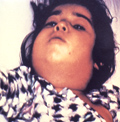 A three-year-old girl in Antwerp, Belgium, has died after being infected with diphtheria.
A three-year-old girl in Antwerp, Belgium, has died after being infected with diphtheria.
The young girl became ill on 6 March and was admitted to intensive care on March 11, according to the European Centre of Disease Surveillance and Control (ECDC).
Tragically, she had not been vaccinated against the disease. Cases of diphtheria are rare in Europe and the disease is included in routine immunisation programmes across the continent.
The ECDC says the risk of a wider outbreak in Antwerp is low because immunisation rates are high and the vaccine provides effective protection.
Where infection occurs, treatment with an anti-toxin can reduce the risk of death and serious illness. In the Antwerp case, the antitoxin was provided on March 16 by the National Institute for Public Health and the Environment (RIVM) in the Netherlands, however, the girl died the next day.
“The limited availability of diphtheria antitoxin in the EU is of concern as early administration of the antitoxin may prevent unfavourable clinical outcomes,” the ECDC said in its regular reports on disease threats in Europe.
Media reports have focused on difficulties accessing the antitoxin but social media channels have been alight with people expressing sadness and shock that a child could die from a preventable illness.
“In Belgium, nearly every child is vaccinated,” Dr Erica Vlieghe of the Antwerp Institute for Tropical Medicine told Belgian media. “If someone is unlucky enough to catch the disease, the treatment is two-fold: antibiotics to kill the bacteria, and a counter-poison against the toxins. The latter has to be administered as soon as possible in serious cases, and this is where things went wrong here.”
Europe had not seen deaths from diphtheria for decades until last year when a six-year-old boy died from the disease in Spain. The child had not been vaccinated.
What is diphtheria?
Diphtheria is an infectious disease affecting the nose, throat and sometimes the skin. It is caused by a bacterium which is spread by coughing and sneezing.
People usually become unwell two to three days after becoming infected. Symptoms range from a moderately sore throat to toxic life-threatening diphtheria of the larynx or of the lower and upper respiratory tracts.
Diphtheria is often complicated by damage to heart muscles, kidneys or peripheral nerves from the toxin produced by the bacteria. It is fatal in up to 10% of cases.
What treatments are available?
In mild cases, antibiotic treatment usually helps people get back on their feet quickly. However, in more serious infections, the lymph nodes in the throat may swell and a thick and sticky membrane develops in the throat making it difficult to breathe or swallow.
In these cases, immediate medical attention is required to protect the patient’s airway. Some patients may need to be intubated (have a tube put down their throat to help them breathe) or to have a tracheotomy (bypassing the obstruction in the throat by cutting a hole in the windpipe)
Is it preventable?
The World Health Organization (WHO) says the most effective way to prevent diphtheria is mass immunisation of the entire population. It is usually given as part of a combination vaccine, in conjunction with vaccines against pertussis and/or tetanus. Regular repeat doses (boosters) are recommended throughout life in order to be confident that the vaccine can be effective against the toxin which is its principle target.
Vaccination programmes have helped make diphtheria very rare in Europe meaning most parents and doctors will never see a single case. However, the bacterium has not been eradicated and there have been outbreaks in developed countries in addition to ongoing outbreaks in the world’s poorest countries.
In the developing world, diphtheria vaccination is among the priorities of international health agencies such as the WHO and UNICEF, as well as non-governmental organisations like the Gates Foundation and the GAVI Alliance.





Pingback
March 7th, 2018
[…] or foodstuffs the child was deficient in, s/he wouldn’t have died. I’m sure that would make this child’s parents feel really good. […]